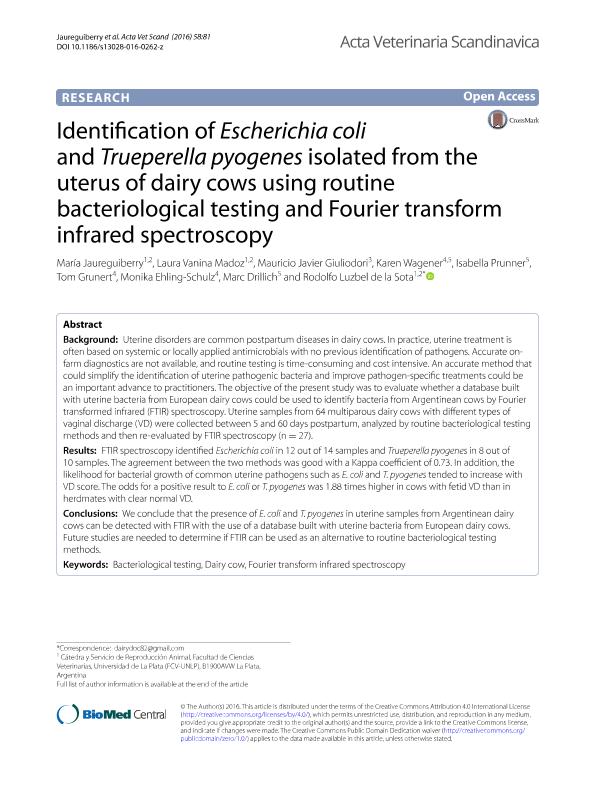Mostrar el registro sencillo del ítem
dc.contributor.author
Jaureguiberry, María

dc.contributor.author
Madoz, Laura Vanina

dc.contributor.author
Giuliodori, Mauricio Javier

dc.contributor.author
Wagener, Karen
dc.contributor.author
Prunner, Isabella
dc.contributor.author
Grunert, Tom
dc.contributor.author
Ehling Schulz, Monika
dc.contributor.author
Drillich, Marc
dc.contributor.author
de la Sota, Rodolfo Luzbel

dc.date.available
2020-08-31T16:59:12Z
dc.date.issued
2016-11
dc.identifier.citation
Jaureguiberry, María; Madoz, Laura Vanina; Giuliodori, Mauricio Javier; Wagener, Karen; Prunner, Isabella; et al.; Identification of Escherichia coli and Trueperella pyogenes isolated from the uterus of dairy cows using routine bacteriological testing and Fourier transform infrared spectroscopy; BioMed Central; Acta Veterinaria Scandinavica; 58; 11-2016; 1-6
dc.identifier.issn
0044-605X
dc.identifier.uri
http://hdl.handle.net/11336/112777
dc.description.abstract
Background: Uterine disorders are common postpartum diseases in dairy cows. In practice, uterine treatment is often based on systemic or locally applied antimicrobials with no previous identification of pathogens. Accurate on-farm diagnostics are not available, and routine testing is time-consuming and cost intensive. An accurate method that could simplify the identification of uterine pathogenic bacteria and improve pathogen-specific treatments could be an important advance to practitioners. The objective of the present study was to evaluate whether a database built with uterine bacteria from European dairy cows could be used to identify bacteria from Argentinean cows by Fourier transformed infrared (FTIR) spectroscopy. Uterine samples from 64 multiparous dairy cows with different types of vaginal discharge (VD) were collected between 5 and 60 days postpartum, analyzed by routine bacteriological testing methods and then re-evaluated by FTIR spectroscopy (n = 27). Results: FTIR spectroscopy identified Escherichia coli in 12 out of 14 samples and Trueperella pyogenes in 8 out of 10 samples. The agreement between the two methods was good with a Kappa coefficient of 0.73. In addition, the likelihood for bacterial growth of common uterine pathogens such as E. coli and T. pyogenes tended to increase with VD score. The odds for a positive result to E. coli or T. pyogenes was 1.88 times higher in cows with fetid VD than in herdmates with clear normal VD. Conclusions: We conclude that the presence of E. coli and T. pyogenes in uterine samples from Argentinean dairy cows can be detected with FTIR with the use of a database built with uterine bacteria from European dairy cows. Future studies are needed to determine if FTIR can be used as an alternative to routine bacteriological testing methods.
dc.format
application/pdf
dc.language.iso
eng
dc.publisher
BioMed Central

dc.rights
info:eu-repo/semantics/openAccess
dc.rights.uri
https://creativecommons.org/licenses/by/2.5/ar/
dc.subject
BACTERIOLOGICAL TESTING
dc.subject
DAIRY COW
dc.subject
FOURIER TRANSFORM INFRARED SPECTROSCOPY
dc.subject.classification
Otras Ciencias Veterinarias

dc.subject.classification
Ciencias Veterinarias

dc.subject.classification
CIENCIAS AGRÍCOLAS

dc.title
Identification of Escherichia coli and Trueperella pyogenes isolated from the uterus of dairy cows using routine bacteriological testing and Fourier transform infrared spectroscopy
dc.type
info:eu-repo/semantics/article
dc.type
info:ar-repo/semantics/artículo
dc.type
info:eu-repo/semantics/publishedVersion
dc.date.updated
2020-08-19T20:22:09Z
dc.journal.volume
58
dc.journal.pagination
1-6
dc.journal.pais
Reino Unido

dc.journal.ciudad
Londres
dc.description.fil
Fil: Jaureguiberry, María. Universidad Nacional de La Plata. Facultad de Ciencias Veterinarias. Instituto de Teriogenología. Cátedra de Reproducción Animal; Argentina. Consejo Nacional de Investigaciones Científicas y Técnicas. Centro Científico Tecnológico Conicet - La Plata; Argentina
dc.description.fil
Fil: Madoz, Laura Vanina. Universidad Nacional de La Plata. Facultad de Ciencias Veterinarias. Instituto de Teriogenología. Cátedra de Reproducción Animal; Argentina. Consejo Nacional de Investigaciones Científicas y Técnicas. Centro Científico Tecnológico Conicet - La Plata; Argentina
dc.description.fil
Fil: Giuliodori, Mauricio Javier. Universidad Nacional de La Plata. Facultad de Ciencias Veterinarias. Departamento de Ciencias Básicas. Cátedra de Fisiología; Argentina
dc.description.fil
Fil: Wagener, Karen. University of Veterinary Medicine Vienna; Austria
dc.description.fil
Fil: Prunner, Isabella. University of Veterinary Medicine Vienna; Austria
dc.description.fil
Fil: Grunert, Tom. University of Veterinary Medicine Vienna; Austria
dc.description.fil
Fil: Ehling Schulz, Monika. University of Veterinary Medicine Vienna; Austria
dc.description.fil
Fil: Drillich, Marc. University of Veterinary Medicine Vienna; Austria
dc.description.fil
Fil: de la Sota, Rodolfo Luzbel. Universidad Nacional de La Plata. Facultad de Ciencias Veterinarias. Instituto de Teriogenología. Cátedra de Reproducción Animal; Argentina. Consejo Nacional de Investigaciones Científicas y Técnicas. Centro Científico Tecnológico Conicet - La Plata; Argentina
dc.journal.title
Acta Veterinaria Scandinavica

dc.relation.alternativeid
info:eu-repo/semantics/altIdentifier/url/https://actavetscand.biomedcentral.com/articles/10.1186/s13028-016-0262-z
dc.relation.alternativeid
info:eu-repo/semantics/altIdentifier/doi/http://dx.doi.org/10.1186/s13028-016-0262-z
dc.relation.alternativeid
info:eu-repo/semantics/altIdentifier/url/https://www.ncbi.nlm.nih.gov/pmc/articles/PMC5126838/
Archivos asociados
